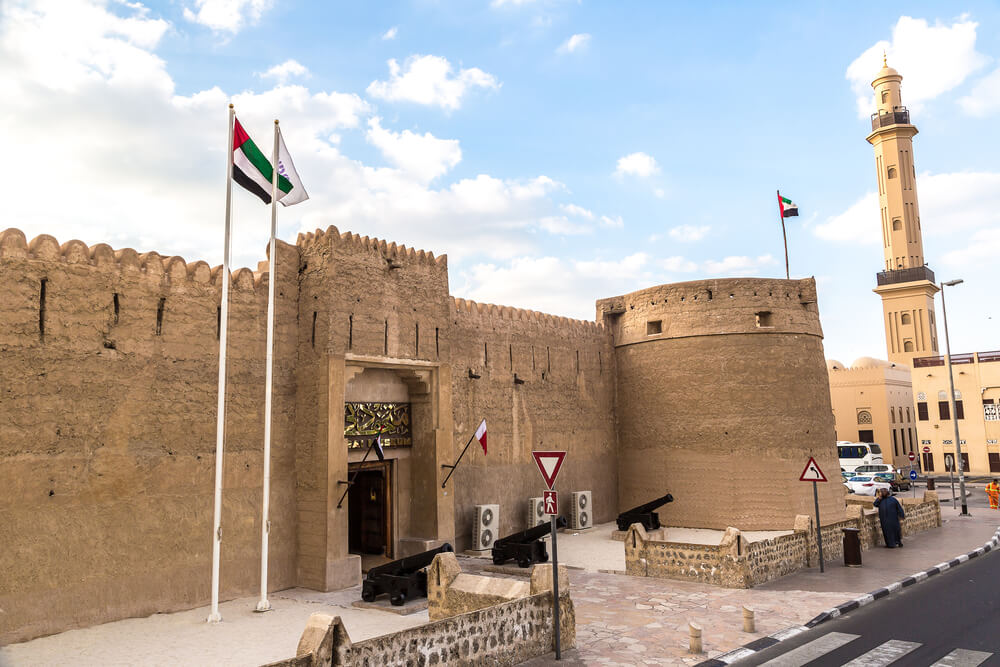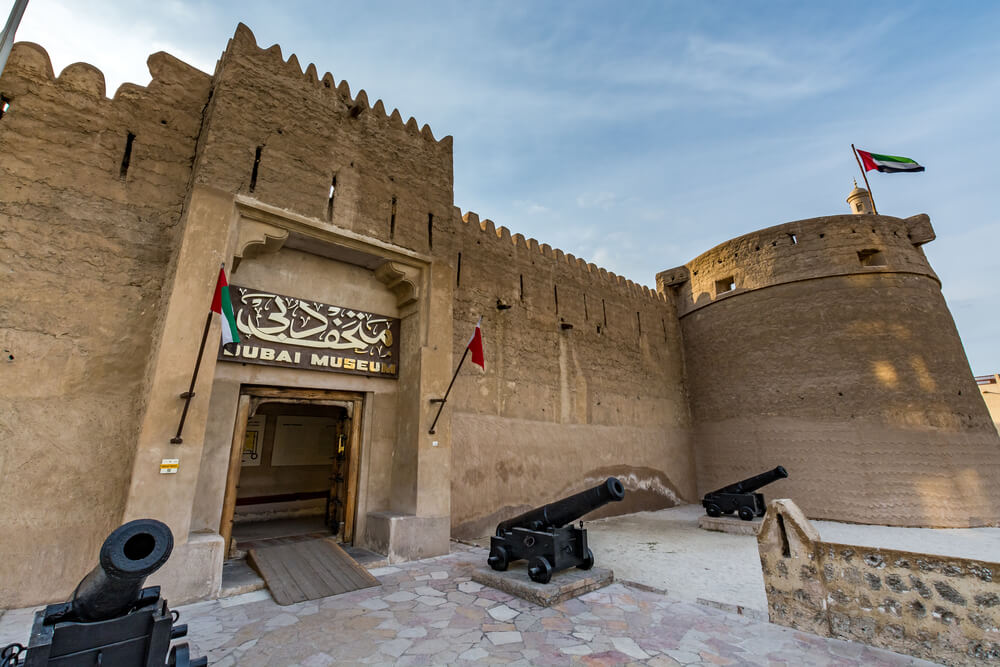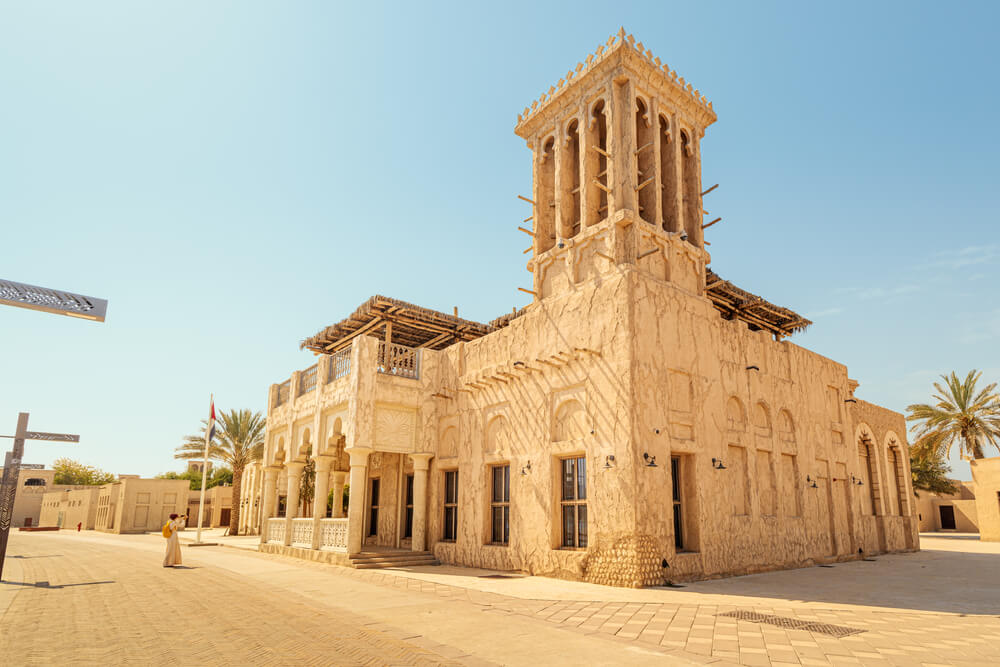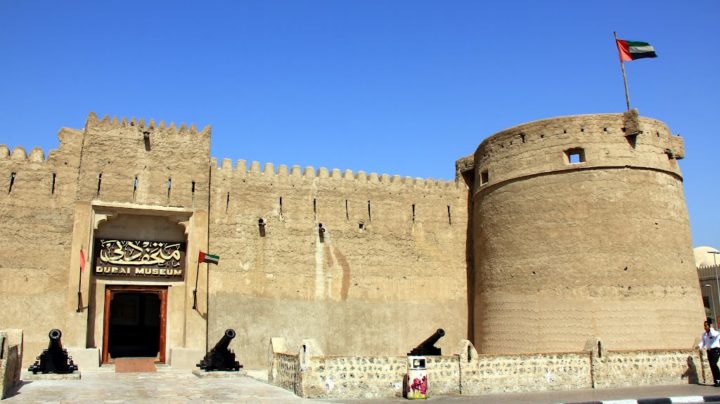Tucked away in the old district of Bur Dubai stands an old fort, the Al Fahidi Fort, that is majestic and full of its ancient glory. This serves as home to Dubai’s Museum. This Museum was established in 1971 by the rulers of Dubai to preserve the history of Dubai and also to make visitors realize that Dubai is not a new city as is described. This Museum is a favorite spot for many historians worldwide to learn about the past that shaped the present Dubai. It is also one of the most frequented spots for tourists and school kids. This Museum is carefully curated to showcase various prehistoric artifacts and fantastic 3-D animated statues depicting the ancient lives of those living in Dubai. Trades like pearl farming, fishing, trading, and the dwellings are beautifully shown and backed up with audio and visual presentation. The old Bastakia area where the Dubai Museum is located provides an ideal backdrop and virtually transforms the area into this Museum’s extension. This area has so many sold souks and buildings with typical heritage architecture inspired by how the residents of the bygone era would make their houses.
Location and Accessibility
The old Dubai Museum is located in the Bastakia district of Bur Dubai. It is very close to the Deira creek. Near this, you will find the iconic Meena Bazar, home to garments and Indian commodities. Along with Deira, Bur Dubai is the oldest part of Dubai. Bur Dubai is also the seat of power, with the ruler’s court just opposite the Al Fahidi fort. The government has preserved the old market, also known as Souk in Arabic. As Bur Dubai lies along the CreekCreek, you will see thousands crossing the CreekCreek from either side on “Abra,” or the water taxi. Earlier, these Abras were simple boats running on diesel, but in 2010, the RTA introduced air-conditioned water taxis that made travel easier between Deira and Dubai.

The Museum is also accessible through the Dubai metro Greenline. It would help if you got down at Sharaf DG metro station, which is a walk of only 10 minutes. You can also take a connecting bus to get down at the Museum Bus station. The Al Fahidi Museum is located close to Dubai’s garment hub, and there will be plenty of taxis willing to take you there.
Dubai Museum is one of the easiest places to reach and the best way to learn about Dubai’s unique past, which helped define its future.
History and Significance
Al Fahidi Fort was built to protect Dubai from invaders from Creek Creek or different directions. The fort was built in many stages, the last completed in 1787. The fort also served as the Sheikh’s living quarters and prison. It also had a watch tower to help locate any untoward movements. The cannon was added to the fort to protect it from more significant attacks.
In 1971, Shek Hamdan Bin Rashid Al Maktoum envisioned a museum for Dubai that would depict its glorious heritage, maritime culture, pearl diving, and various other aspects that were slowly vanishing due to the rapid modernization of its economy that was reshaping its culture and heritage. He wrote to Sheikh Sabah to ask for an expert to consult the Dubai government. That is how it all began. The Museum is significant because;
It depicts the culture of Dubai since its ancient times beautifully through dioramas that look absolutely real and stunning. A culture is preserved and valued only when it is available in a form that is easy to see and visualize. Dubai Museum has successfully achieved this by capturing various aspects of its culture through these exhibits.
A city that claims to be centuries old must have something else apart from its culture to prove its claims. Dubai Museum showcases its ancient architecture, making living in the desert much easier. Although home to some of the most remarkable high-rises and stunning buildings, there were times when it had to rely on its unique architecture, which was an engineering marvel. When you visit the Dubai Museum in the Al Fahidi fort, you will see how wind towers were used to capture outside air, guide it to the internal parts of the fort or house, and keep it cool.
The old Museum also has some artifacts found in and around Dubai that are more than a thousand years old. These artifacts prove that Dubai was a trading hub during ancient times, and local Arabs used to trade with India, China, and Iran.
This Museum offers many insights into Dubai’s past and present.
Architecture Layout
The Museum is located inside the Al Fahidi Fort, which typically depicts the local Emirati architecture used in those days for operational and defensive purposes. The architecture can be studied through its External and Internal designs.
Externally, the structure consisted of Fort Walls, Watchtowers, and a Main entrance. The Fort walls were made from coral rock, seashells, and gypsum, which provided strength and solidity to the architecture. The watchtowers were used for surveillance and were the highest in the fort to facilitate viewing and prevent attacks.
When you enter the fort, visitors gather in a huge lobby in a courtyard. There used to be a small marketplace where traders could come and trade their wares. The courtyard also features a huge wooden dhow used for fishing and pearl diving.
The fort has three distinct towers on its three corners. The Round Tower, also known as the Wind Tower, is the highest tower and serves as the main surveillance tower, providing a panoramic view of the city. This tower was uniquely designed to let air circulation inside the fort and keep it cool. The square and rectangle towers also served for defensive and observational purposes.

The courtyard led to various rooms around it that the sheik and his family used. Currently, these rooms are used to exhibit various arts and artifacts of ancient Dubai, including its weaponry, clothes worn by its people, and everyday items. The underground area that once served as a prison now serves as an exhibition of prehistoric items that were found across Dubai as well as life-size dioramas that showcases the traditional lifestyle of local Bedouin people, the original inhabitants of Dubai.
Main Exhibits and Displays
The Old Museum of Dubai is a huge collection of monuments, artifacts, Displays, and 3D dioramas. The monuments section is curated to display weaponry, household items such as pottery, and tombs that educate you on how the ancient people of Dubai lived and thrived and what happened when they passed away. Some prehistoric items were found during excavations around Dubai. Then, there is the Lifestyle section, which has dioramas in its rich and vibrant clothing that showcase the fashion and social lives of Bedouins of Dubai. This section also showcases the wildlife of Dubai. The Masjid and traditional homes section displays old houses and wind towers and the slow evolution of traditional Bedouin Arab homes to the ultra-modern architecture of Dubai. There are exhibits of pearl diving, shipbuilding, and trading that show how strong Dubai was in terms of seafaring. The traditional commercial acumen and good knowledge of the sea helped Dubai sustain itself even when oil had dried up fully. The Museum itself is an exhibit of traditional homes that were built by local Bedouins who used tall wind towers to cool their homes, a central courtyard as a majlis, and rooms around it as living quarters.
Traditional Arab Houses and Life
A traditional Arab house is usually made up of lime and coral blocks. It had a squarish wind tower that let air into the home. The house started with a courtyard called the “Majlis .”This courtyard led to many rooms inside. Mostly, the ladies had living quarters at the backside to ensure their privacy in an Islamic way. The men usually used to sit in the Majlis and entertain guests. The men were either into trading, shipbuilding, or pearl diving. Fishing was also an important avocation. The local Arabs used to travel as far as China, Africa, and India in their wooden dhows. They would trade in spices, dates, and silk. Iran was also an important trade destination. The women mostly lived in veils and never stepped out. However, they were very important members of the family, as they would children, cook, and take care of the house. Women would also do stitching and weaving. The Arabs also used to hunt, as a lot of wildlife is on display from ancient Dubai.
Archaeological Finds
Like any other ancient city in the world, Dubai also had its share of archaeological finds. These finds happened while accidentally excavating construction sites. These finds led to further careful examination and further excavation by archaeologists. The finds mainly included prehistoric pottery, hunting tools, and jewelry. Some of these findings have been found to be from the year 3000 BC. These findings indicate that Dubai has a long history of human habitation, trade, and wildlife.
Galleries and Artefacts
Dubai Museum has been curated to showcase the rich history of Dubai. This is done through various galleries. These galleries are:
Archaeological Finds Gallery: Here, you will find the oldest and most ancient finds from various archaeological excavations in Dubai. These include pottery, weapons, hunting tools, and jewelry dating back to 3000 BC.
Al Fahidi Fort Gallery: This showcase the history of the fort itself. once standing tall and strong, this fort has a lot of stories to tell. this gallery also displays the material used to build the fort, layout, and architectural details.
Traditional Life Gallery: The traditional Bedouin lifestyle is showcased through traditional life gallery. This is done through life-size dioramas that depict scenes from the souk, traditional homes as well as desert life. Dioramas of men and women, and children are almost real with their traditional clothing.
Pearl Diving Gallery: This Highlights the importance of pearl diving in Dubai’s history, with exhibits of diving equipment and pearls, boats used for pearling, and images of pearl findings.
Maritime Gallery: Dubai has a great maritime history. This gallery displays models of traditional boats and maritime artifacts, illustrating Dubai’s seafaring heritage.
Weapons and Defense Gallery: It is a well-known fact that all ancient cities faced wars. Dubai has a strategic location as it opens doors to Iran, India, and the West. Many wars have been fought to protect its independence. The gallery exhibits a collection of old weapons and defense tools, including daggers, swords, and cannons.
Artifacts Finds
Pottery from a bygone era consisting of Various pieces from different historical periods. Intricate jewellery pieces reflecting the artistry and cultural influences of the region. Weapons and Tools that include daggers, swords, and axes. Pearl Diving Equipment and tools used in the pearl diving era. It also displays traditional musical instruments that were used in traditional Emirati music. There is an interesting section of antique furniture pieces that are used in traditional Emirati craftsmanship.
The Museum also features interactive displays and multimedia presentations that bring these historical artifacts to life.
Interactive Displays and Multimedia
The Al Fahidi Museum offers a range of interactive and multimedia experiences to add to your visual treatise. This enhances visitors’ experience and knowledge of Dubai’s history, culture, and traditions. These include a) Historical films and documentaries to provide an overview of its history, its early days of being a small fishing village and its transformation into one of the most modern metropolis, b) A digital map that enables you to explore different historical sites and landmarks when a visitor puts his finger on a particular point on the map, c) There is also a multi-language audio guide that offers a detailed explanation of the exhibits and artifacts, that enriches visitor’s understanding about these precious items.

The Museum also has a touchscreen-based explanation system. This digital innovation leads you to touch a point on the screen, and it expands to display the finer aspects of the point. Another digital innovation is the introduction of VR, which takes visitors back in time, giving them a first-hand experience in pearl diving, fishing, and roaming in the courtyard of an ancient Dubai house. You may also have a first experience in creating some art pieces that mimic the artifacts found there through clay and lego pieces.
Events and Educational Programs
The Dubai Museum management has been creating interesting events and educational programs to engage visitors of every age group and background in learning and enhancing their awareness about Dubai, its Bedouin culture, and traditions. The Dubai Museum offers a variety of events and educational programs designed to engage visitors of all ages and backgrounds. Here are some of the key offerings:
Events
Cultural Festivals: There are cultural events organized to celebrate the local Bedouin culture and traditions. Bedouins have been the original inhabitants of Dubai since the time when it was a small fishing village. The Bedouin culture is highly influenced by Islam. The culture festival includes organizing festivals like Eid as well as bringing in local Arabs and organizing typical Emirati dance.
Heritage Days: It organizes Heritage Days event to showcase heritage activities like falconry, camel riding, and traditional cooking. These activities are performed by real Arab artists with in-depth experience and knowledge. The visitors are allowed to interact with them as well as take pictures and videos.
Special Events: The management also organizes special events time to time. These events are focused on aspects such as Emirati history, Pearl Diving, Fishing, and trade. It also organizes special events around falconry and camel riding.
There are programs like
School Visits: It organizes tailored programs for school groups, that includes guided tours and interactive workshops that align with educational curricula. In fact it works with KHDA (Knowledge and Human Resource Development Authority, Dubai) in order to create special educational programs.
Workshops: It also conducts hands-on workshops for children and adults, covering topics such as traditional crafts, archaeology, and Emirati culture.
Lectures and Seminars: The Museum organizes special educational talks and seminars by historians, archaeologists, and cultural experts on various topics related to Dubai’s history and heritage.
The Museum conducts Family Programs that include storytelling sessions, scavenger hunts, and art projects that encourage learning through play. These programs and events aim to provide a deeper understanding of Dubai’s rich cultural heritage.
Visitor Facilities and Amenities
The Museum has a lot of facilities and amenities. Dubai is typically well-known for providing top-class amenities to tourists at every point of interest. Hence, the Dubai Museum is no exception. Apart from hygienic washrooms, it has a special area for mothers and babies. For differently-abled people, it has special amenities to make it easy for them to go around on a special caddy. There are also enough chairs in the Museum to sit and relax in case one is very tired. The Museum has a car park adjacent to it for visitors to park their cars. However, please note that these parking spaces are paid parking zones. There is a marketplace and cafeteria for visitors to enjoy a cup of coffee while on tour.
Nearby Attractions
As the Dubai Museum is in Bur Dubai, there are a lot of attractions in its vicinity. The Creek is just a walking distance. I plan to get on a water taxi and go to the other side of the old Dubai called Deira. There are plenty of water taxis plying every minute, so you can just stroll on the other side and come back. An old-style souk is also in the vicinity, where you can buy exotic spices and gift items. In its vicinity, there is an iconic Indian market known as “the Meena Bazar.” This place has everything from India, including gold jewelry, Fabrics, Fashion Clothing, Food, and plenty of restaurants. This place is a shopping paradise. Of course, you stroll up north, and you will get to see the Al Shandaga Heritage area, known for its traditional coffee shops, Emirati food, and exhibitions. Al Seef area is also very close by, and it has been developed to fuse heritage, history, and modernity, which is reflected in its fashionable cafes, shops, and the world-famous Museum of Illusions.
Best Time to Visit
Anytime is a good time to visit this fantastic place. As you need a lot of energy to go around, choose the winter months to visit the Museum. However, as the entire Museum is fully airconditioned, you may also visit during summer. However, it would be challenging to enjoy the nearby attractions as much as possible.
Tips for Visiting Dubai Museum
We advise you that you be prepared for a lot of walking. Do not talk loudly or make fun of any exhibit. Do not touch any artifacts. You must follow the instructions so that you allow others to enjoy as much as you want to enjoy the trip. Enjoy all the immersive experience of all interactive shows.
Conclusion
The Dubai Museum, also known as the Al Fahidi Museum, is a great place to become aware of Dubai’s rich history, traditions, culture, and architecture. Dubai Museum attractions also include exhibits of artifacts from 3000 BC. The things to see at Dubai Museum are curated carefully by famous historians to achieve a balance between ancient artifacts and their heritage. While the best time to visit Dubai Museum is the winter months, you may choose any time of the year to visit and have a day of fun and learning.
FAQs:
What is the entry fee for the Dubai Museum?
The entry fee for adults is only Aed 3, and kids below six can enter by paying only Aed 1.
How long does it take to tour the Dubai Museum?
It all depends on you. You can take a quick tour of the Museum in under two hours or spend one full day enjoying the audiovisual presentations, interactive and VR experiences, and touchscreen-based detailing.
Is photography allowed inside the Dubai Museum?
Selfies are allowed in certain places. However, heavy cameras are not permitted because artifacts are delicate and may be damaged by harsh lights. Check the latest rules at the entrance and follow them.

